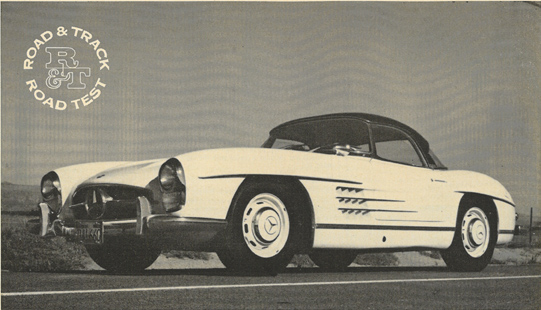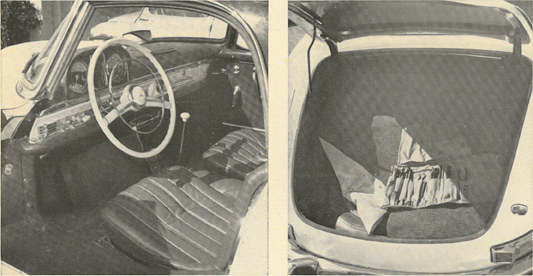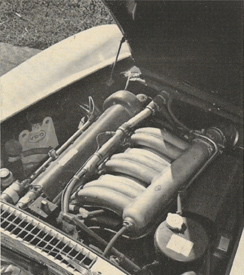
300SL under scrutiny
R&T Road Test
Ask ANY SPORTS CAR ENTHUSIAST what he considers to be the best, most desirable sports car in the world, and chances are better than even that he’ll say Mercedes 300-SL without hesitation. This answer will, naturally, bring on cries of dismay and snorts of indignation from Ferrari and/or Aston Martin boosters.
The basis for each person’s argument is, to a certain extent, one of personal taste or preference, and may have been based on personal contact with one or more of the best-ranked cars, but more likely it is the result of company prestige and reputation For no matter what racing does or does not do to Improve the breed, it does build prestige for a. Company with-a successful racing department, viz., Ferrari, Porsche and Daimler-Benz And who’s to say that racing hasn’t Improved these cars?
This is the third example of the 300-SL series to be tested by Road & Track: the 300-SL ‘gullwing’ coupe in 1955, the 300-SL roadster in 1958 and now the 300-SL roadster with removable hardtop.
Improving a legend
Changes and improvements have been minor (on the surface) m the last three years, but have made a good car better by constant refinement and attention to detail. Exterior appearance and interior appointments are virtually identical to the car tested three years ago.
Speaking of appearance, few will quarrel with the businesslike looks of the 300-SL. The lines are soft, yet leave no doubt as to the car’s purpose. It signifies power and speed as few designs do, and the appearance seems to appeal equally to men and women, even though it is a man’s car (more on this later). We prefer the older gullwing coupe to the roadster, but this is strictly a matter of personal choice, as there’s little real difference in over-all appearance.
Graceful entry/exit
In designing the roadster, the complex space frame of the coupe was retained but was altered around the cockpit area so lower doorsills could be utilized. This makes getting in and out a bit easier, especially for members of the fair sex, who sometimes wear skirts, even in sports cars, and who don’t seem to have any trouble in getting the owners of these cars to take them for a ride. We still found it to be somewhat awkward getting into the 300-SL (old age?), but very much worth the effort.
The 4-wheel independent suspension, unequal length A-arms In front, low-pivot swing axle in the rear is unchanged from our test car of three years ago and is similar to that of all 300-SLs built since 1952. The major change has been in the rear suspension where the low-pivot design was adopted at the same time as the body change from coupe to roadster. Springs are coil all around and shock dampers are tubular hydraulic.
The interior appointments of the 300-SL are in keeping with the five figure price tag and have successfully separated this car from the category of stark functionalism fitting the die-hard sports car enthusiast’s ideas of what a sports car should be. Due to the car’s de luxe interior, and the relatively heavy weight (which is rather far afield from the company’s designation of SL, meaning Super Light) we would actually classify the add as a Grand Touring car, rather than a sports car. And what grand touring it is!

Refinement on the road
The individual, upholstered-in-leather, bucket seats are comfortable almost to a fault, very successfully limiting side movement of driver and passenger. A time or two, during our more exuberant dashes through the mountains, we felt the need for seat belts, but then both members of the test crew have belts in their own cars and are used to them.
A pleasant touch, which more cars should have, and a result of the competition experience of Daimler-Benz, was the perforated upholstery which allows a certain amount of air circulation through the seat cushion, thereby cooling the driver’s derriere. Some upholstery material does not breathe and on a hot day the car’s occupants end up sitting in wet seats.
The loudest noise to be heard from this ultra silent car is the whir of the injector pump as the ignition key is turned on. A few additional degrees of rotation (of the key) actuates the starter and the engine bursts into life. We had some trouble starting the car after it had been sitting all night, but this was largely due to inexperience with the car and its fuel injection system. Normal starts were made with no trouble at all and we know of no owner who has regular trouble starting his own car unless he has let it get badly out of tune.

300SL among the masses
Getting underway in ordinary traffic or striving for maximum acceleration proved to be easy and the clutch always had a firm, smooth bite. Never during our test did we experience difficulty with the clutch in any way. Even after the acceleration tests it was still smooth and positive.
The transmission also proved to be as we remembered it: quick, positive and easy to shaft with the lever falling conveniently to hand. All four well-spaced ratios have synchromesh, and shifting up or down was accomplished with a minimum of fuss and effort.
The steering is another matter. To be sure, it is positive and direct, and the wheel is positioned in such a manner that most drivers can and a seating position to suit themselves, but the steering is incredibly stiff. Getting the car in or out of a parking place was real work. Leaving town and driving on an expressway eased the burden and the steering seemed to lighten up. From the thruways onto rural roads, and finally hilly country, brought out the stiffness of the steering once again.
text/photography from road&track magazine